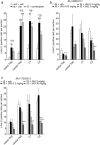Two TRPV1 receptor antagonists are effective in two different experimental models of migraine
- PMID: 26109436
- PMCID: PMC4491068
- DOI: 10.1186/s10194-015-0539-z
Two TRPV1 receptor antagonists are effective in two different experimental models of migraine
Abstract
Background: The capsaicin and heat responsive ion channel TRPV1 is expressed on trigeminal nociceptive neurons and has been implicated in the pathophysiology of migraine attacks. Here we investigate the efficacy of two TRPV1 channel antagonists in blocking trigeminal activation using two in vivo models of migraine.
Methods: Male Sprague-Dawley rats were used to study the effects of the TRPV1 antagonists JNJ-38893777 and JNJ-17203212 on trigeminal activation. Expression of the immediate early gene c-fos was measured following intracisternal application of inflammatory soup. In a second model, CGRP release into the external jugular vein was determined following injection of capsaicin into the carotid artery.
Results: Inflammatory up-regulation of c-fos in the trigeminal brain stem complex was dose-dependently and significantly reduced by both TRPV1 antagonists. Capsaicin-induced CGRP release was attenuated by JNJ-38893777 only in higher dosage. JNJ-17203212 was effective in all doses and fully abolished CGRP release in a time and dose-dependent manner.
Conclusion: Our results describe two TRPV1 antagonists that are effective in two in vivo models of migraine. These results suggest that TRPV1 may play a role in the pathophysiological mechanisms, which are relevant to migraine.
Figures


Similar articles
-
Olvanil acts on transient receptor potential vanilloid channel 1 and cannabinoid receptors to modulate neuronal transmission in the trigeminovascular system.Pain. 2012 Nov;153(11):2226-2232. doi: 10.1016/j.pain.2012.07.006. Epub 2012 Aug 14. Pain. 2012. PMID: 22902197
-
Cross-effect of TRPV1 and EP3 receptor on coughs and bronchopulmonary C-neural activities.PLoS One. 2021 Feb 2;16(2):e0246375. doi: 10.1371/journal.pone.0246375. eCollection 2021. PLoS One. 2021. PMID: 33529249 Free PMC article.
-
Selective inhibition of 5-HT7 receptor reduces CGRP release in an experimental model for migraine.Headache. 2010 Apr;50(4):579-87. doi: 10.1111/j.1526-4610.2010.01632.x. Epub 2010 Mar 5. Headache. 2010. PMID: 20236348
-
TRPV1 in migraine pathophysiology.Trends Mol Med. 2010 Apr;16(4):153-9. doi: 10.1016/j.molmed.2010.02.004. Epub 2010 Mar 27. Trends Mol Med. 2010. PMID: 20347391 Review.
-
Neurotrophins and Migraine.Vitam Horm. 2017;104:459-473. doi: 10.1016/bs.vh.2016.10.003. Epub 2016 Nov 29. Vitam Horm. 2017. PMID: 28215304 Review.
Cited by
-
Evaluation of Serum Levels of Transient Receptor Potential Cation Channel Subfamily V Member 1, Vasoactive Intestinal Polypeptide, and Pituitary Adenylate Cyclase-Activating Polypeptide in Chronic and Episodic Migraine: The Possible Role in Migraine Transformation.Front Neurol. 2021 Dec 23;12:770980. doi: 10.3389/fneur.2021.770980. eCollection 2021. Front Neurol. 2021. PMID: 35002925 Free PMC article.
-
Mechanosensitive receptors in migraine: a systematic review.J Headache Pain. 2024 Jan 15;25(1):6. doi: 10.1186/s10194-023-01710-1. J Headache Pain. 2024. PMID: 38221631 Free PMC article.
-
The need for new acutely acting antimigraine drugs: moving safely outside acute medication overuse.J Headache Pain. 2019 May 16;20(1):54. doi: 10.1186/s10194-019-1007-y. J Headache Pain. 2019. PMID: 31096904 Free PMC article. Review.
-
A bibliometric review of drug repurposing.Drug Discov Today. 2018 Mar;23(3):661-672. doi: 10.1016/j.drudis.2018.01.018. Epub 2018 Jan 9. Drug Discov Today. 2018. PMID: 29330123 Free PMC article. Review.
-
Targeting Nociceptive Neurons and Transient Receptor Potential Channels for the Treatment of Migraine.Int J Mol Sci. 2023 Apr 26;24(9):7897. doi: 10.3390/ijms24097897. Int J Mol Sci. 2023. PMID: 37175602 Free PMC article. Review.
References
-
- World Health Organization . The global burden of disease: 2004 update. 2008.
-
- Lipton R, Buse D, Serrano D, Ng-Mak D, Pearlman S, Reed M. Examination of unmet treatment needs among persons with episodic migraine (EM): Results of the American Migraine Prevalence and Prevention Study (AMPP) (P1342) Eur J Neurol. 2011;18:66–343. doi: 10.1111/j.1468-1331.2011.03551.x. - DOI
MeSH terms
Substances
LinkOut - more resources
Full Text Sources
Other Literature Sources
Medical
Research Materials

